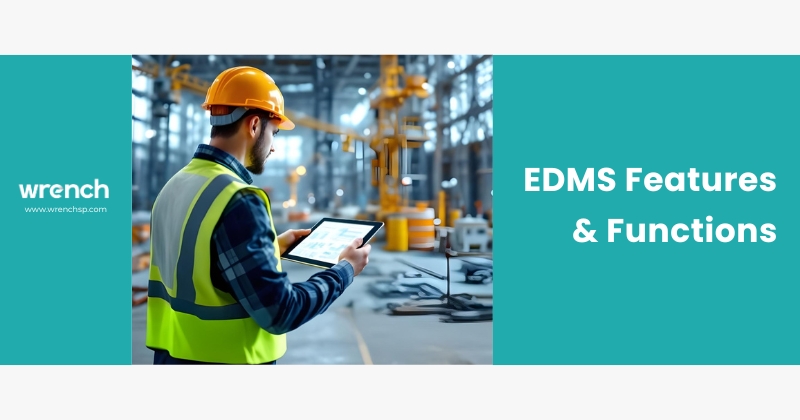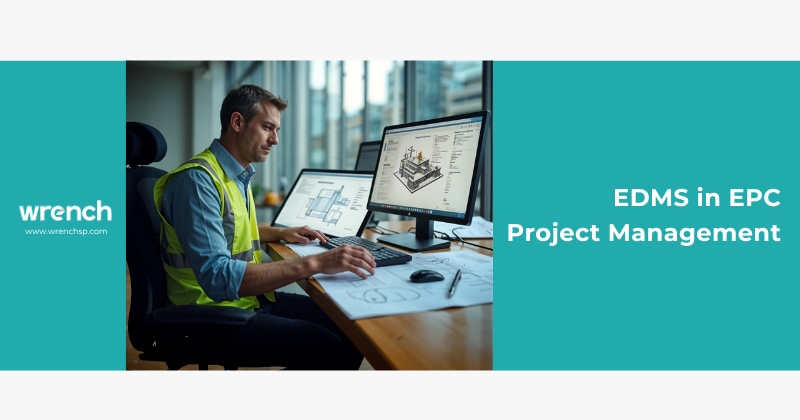- Blog EDMS Engineering Drawing
- 10 Apr 2025
EDMS Features and Functions

When an EPC organisation, be it an owner, architect, contractor, or consultant, starts on a journey of digital transformation the first step is likely an EDMS or engineering document management system. The expectation is that this EDMS will help organise the company’s project documentation and data more efficiently, thereby leading to more productivity and savings down the line. However, not many know that the modern EDMS offers functions and features beyond document management and will impact not just the organisation data but its business line, its brand power, and its future growth. Today EPC companies are realising that EDMS can be a game-changer in competitive and time-sensitive infrastructure verticals and provide a clear advantage in terms of being able to deliver work on time and within the stipulated schedule – something which is more the exception than the rule in the EPC industry. They are also realising that EDMS works from the bottom up, from document management upwards to deliverable and project delivery management, until the ripple effect visibly impacts the project’s trajectory for the better.
Companies that invest in EDMS report faster document search speed, fewer human errors – such as accidentally using the wrong version of a drawing – and fewer duplicates, all of which contribute to the engineering team’s productivity and even morale as teams don’t have to worry about firefighting and rework and are able to prevent delays and conflict.
With EDMS, companies have a foolproof way to meet compliance, quality, and other regulations and this can help with trust and brand value. EDMS also changes the way teams interact with each other by moving away from the old siloed and isolated approach and instead allowing everybody involved in the project and (all the stakeholders) to work securely together in the same shared virtual environment. This changes the work culture in a fundamental way; the reliance on human effort decreases and managers are able to shift focus from reactive methods of project management to proactive or preventive ones.
So the benefits of EDMS are becoming well known across the industry. Today I will talk about some EDMS features that impact the way EPC organisations work.
Since the market for EDMS exploded there are many types and levels to choose from, but some basic features are common to every EDMS across brands, like the conversion of hard copies into digital files and the subsequent normalisation and standardisation of the digital data, as well as the elimination of many hours of tedious manual effort required for the creation, storage, updation, and sharing of data and documents during the project lifecycle. This digitisation of data not only offers the benefit of saved time and space, it allows users to get almost-instant access to the data via digital devices like computers, tablets, and smartphones. And following on from this comes the huge benefit of system-driven versioning instead of the old manual methods of maintaining document versions and revisions; and when you consider how many documents a typical project entails and how many versions and revisions of each document typically ensue during the project’s trajectory over time, the savings in the process of change and revision management when you adopt an EDMS is not small.
Now we come to the less common features which are present only in the more advanced EDMS.
Let’s start with built-in workflows. These are step by step, vertical-specific procedures for various project tasks like getting a client approval for a drawing or reviewing a drawing across disciplines. In most industries there are strict rules and regulations governing such tasks and with a modern EDMS those rules ie the step by step procedures can be configured for each customer and built right into the EDMS software by the software developer. Thus, once people start using the EDMS, everybody will automatically be following the best practices and regulations and protocols specific to that organisation, which makes it much easier to achieve quality in the final deliverable.
Another advanced feature is the audit trail feature. This is a mechanism in the software that automatically captures all the actions and interactions made to a document, including the person making those actions and interactions, and this creates a permanent record that can be easily ‘audited’ at a later stage. So managers can quickly zoom in on any deviation and trace it back to its source and take preventive or corrective actions as required.
Next, we have a very important feature in today’s complex digital environments, and that is the ability to integrate with other applications and platforms, like corporate email and spreadsheets and AutoCAD and ERP and project planning or scheduling applications like MSproject or Primavera. A good EDMS will ‘talk’ to all these other software and will have a centralised document database, so that a user can access a wide variety of files from within the EDMS itself without having to constantly switch back and forth between applications.
To conclude, the EDMS of today has features that go beyond mere document and data management, and these have, in fact, led to the rise of the idea of a ‘Single Source of Truth’. This idea of a single centralised source of ‘truth’ that is both reliable and accurate would have been unthinkable a few years ago but is rapidly becoming a must-have for all EPC project stakeholder organisations and since EDMS is a growing field, we can expect to see more and more innovative ideas and features in the future as well.
Shabna has over 7+ years of experience in the construction project management sector, having worked with leading consultancies like AECOM, Colliers, and CBRE. She is a Civil Engineer with a Master’s degree in Building Engineering and Management from SPA, New Delhi, and has a deep understanding of project management processes with a focus on project controls and presentation.
Related Posts

Engineering DMS vs Electronic DMS
The term EDMS has become commonplace in engineering-related sectors these days, especially in EPC project verticals where the management of technical documentation is a key factor in successful project delivery. It must be noted that…
- 04 Apr 2025

What is an EDMS?
EDMS has become popular in the EPC world in the last decade, especially after the pandemic. What is EDMS? At its core, EDMS is an electronic document management system or a software that organises and…
- 20 Mar 2025
Archives
- April 2025
- March 2025
- February 2025
- January 2025
- November 2024
- October 2024
- September 2024
- August 2024
- July 2024
- June 2024
- May 2024
- April 2024
- March 2024
- January 2024
- December 2023
- November 2023
- September 2023
- August 2023
- July 2023
- June 2023
- May 2023
- April 2023
- March 2023
- February 2023
- January 2023
- December 2022
- November 2022
- September 2022
- June 2022
- May 2022
- April 2022
- March 2022
- January 2022
- November 2021
- October 2021
- July 2021
- June 2021
- May 2021
- March 2021
- February 2021
- January 2021
- December 2020
- November 2020
- September 2020
- August 2020
- June 2020
- April 2020
- March 2020
- February 2020
- January 2020
- November 2019
- October 2019
- September 2019
- August 2019
- April 2019
- March 2019
- December 2018
- October 2018
- September 2018
- August 2018
- July 2018
- June 2018
- May 2018
- April 2018
- January 2018
- November 2017
- October 2017
- September 2017
- May 2017
- April 2017
- March 2017
- February 2017
- January 2017
